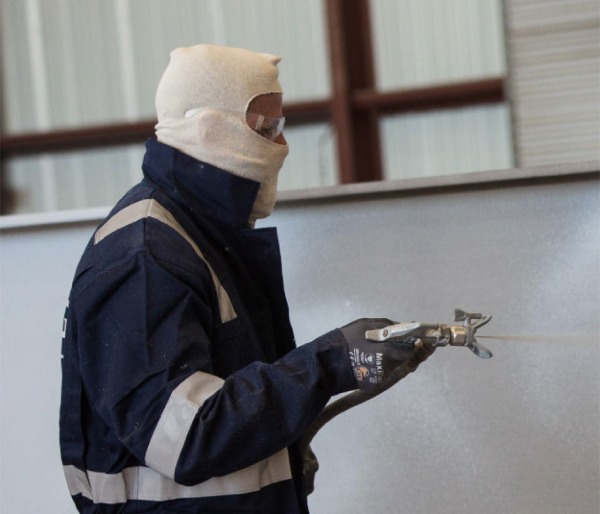Protective Coatings Solutions
PPG’s Richard Mann discusses why accurate fire testing matters; how standards differ; and what contractors need to know to ensure compliance.
Published 27 October 2025

For its protective and marine coatings business, Richard Mann leads PPG’s advancements in the development and validation of fire protection coatings that protect structural steel. In this article, he discusses why accurate fire testing matters; how standards differ; and what contractors need to know to ensure compliance.
Richard Mann has spent his entire career in the fire protection industry. From his roots as a research and development (R&D) chemist to his current role as PPG global product manager, Mann has witnessed firsthand how evolving building codes, fire testing standards, and new product technologies have shaped the development of intumescent coatings for passive fire protection (PFP) in modern infrastructure.
At PPG’s protective and marine coatings business, Mann leads PPG’s advancements in the development and validation of fire protection coatings that protect structural steel.
In this question-and-answer (Q&A) article with AMPP Media, he discusses why accurate fire testing matters, how standards differ and what contractors need to know to ensure compliance on critical projects.
Q: Tell us how intumescent coatings are different from other passive fire protection (PFP) solutions.
Mann: Intumescent coatings, cement sprays, and fire boards are all designed to insulate structural steel from the high temperatures of cellulosic fires. When exposed to extreme heat, intumescent coatings expand and form a char layer that extends the time to the calculated failure temperature, helping to protect the steel from structural failure.
Unlike other PFP solutions, these thin and lightweight coatings provide a smooth paint-like finish that can expand up to 50 times the applied dry film thickness (DFT).
Q: What does fire testing evaluate in intumescent PFP coatings?
Mann: The goal of fire testing remains to replicate the real-world conditions structural steel will face in a fire and measure the coating’s ability to stay in place and insulate the steel from high temperatures.
Testing is conducted on a wide variety of steel shapes and constructions. Using hydraulic rams, labs simulate loads on beams and columns. Floor and roof systems are always tested as assemblies, not individual pieces, because their performance depends on the interaction of multiple components. Primers and topcoats also need to be tested for compatibility to ensure the intumescent coating can maintain adhesion and expand as needed.
Fire testing produces an assessment document that defines the DFT for various shapes, sizes, and fire ratings, ranging from 20 minutes to 3 hours. Contractors rely on this technical foundation to apply coatings correctly.
Q: How do different fire testing standards affect contractors and specifiers?
Mann: No central governing body for fire testing exists. Instead, many fire standards developed by different organizations, such as UL Solutions and ASTM International, govern. For most standards, manufacturers rely on third-party labs to conduct testing procedures. As a result, testing accuracy and transparency prove essential.
Local building codes specify the required standard and fire rating for each type of project. Fire testing data is only valid when matched precisely to the standard cited in the code. Substituting a coating that meets one standard for another, even if they seem similar, proves unacceptable. Building officials frequently update codes, so project teams must stay informed to ensure compliance.
Q: What are the risks of inaccurate fire testing?
Mann: Even small deviations in testing conditions can produce misleading results. Furnace calibration errors may produce temperatures that are too low, which can lead to inaccurate coating performance in real fires.
Inaccurate loading conditions can impact DFT requirements and leave structures without adequate insulation. The consequences of faulty fire testing can result in project delays, increased maintenance costs, and in the worst-case scenario, catastrophic structural failure that occurs faster than expected.
Q: What role does accurate fire testing play in cost efficiency?
Mann: Accurate testing data means fewer reworks and lower lifecycle costs. A PFP coating system with an approved primer and topcoat can have an extended service life of more than 20 years with reduced maintenance.
Applying coatings too thick can cause them to crack, leading to additional labor and repair costs, while applying them too thin can prevent the system from achieving the required fire rating performance.
Q: What are your tips for selecting compliant PFP solutions?
Mann: It starts with transparency. Always ask the coatings supplier about the standards and methods used to test the system, where the testing was conducted, and whether assessment documents and technical data sheets are available. A supplier committed to fire safety will have that information ready. Verification is just as important, and when possible, certifications can and should be independently checked.
Coatings must be tested to the exact standard specified in the local building code. Standards are not interchangeable, and neither are fire rating classifications. A system tested for a beam rating cannot be assumed to work in a floor assembly without separate testing.
Finally, choose partners you can trust. Work with suppliers that have a proven track record and are open with their testing data. We’ve invested heavily in testing procedures and our own multiple regional testing facilities, like our global fire protection technology center in Kunshan, China, to ensure we can keep pace with changing requirements.
When contractors and specifiers work with suppliers who are committed to transparent and verifiable testing practices, the result is projects that are safe, compliant, durable and cost-efficient.
Richard Mann is PPG senior manager, science and technology development for cellulosic fire protection for protective and marine coatings.
Originally published in CoatingsPro
Download PPG’s latest white paper, “Understanding Fire Testing Practices for Cellulosic Passive Fire Protection Systems: A Critical Component of Structural Safety,” here.
